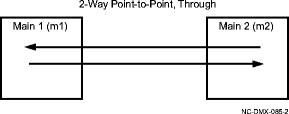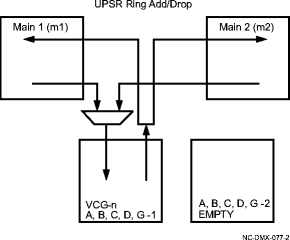Procedure 11-31: Make cross-connections for LNW73/LNW73C FC-DPORT SAN transport service
 Overview
Overview
This procedure provides examples for making cross-connections for SAN transport service using the LNW73/LNW73C circuit pack.
Steps
Use this procedure as an example for making cross-connections for SAN transport service.
1 |
Use the WaveStar® CIT to log in to one of the terminating nodes. Reference: Procedure 14-2: Connect Personal Computer (PC) and establish WaveStar® CIT session |
2 |
On the System View menu, select Administration → OSI Neighbor Map command and note the NEs connected to Main 1 and Main 2. Access each of the NEs identified and select the Administration → OSI Neighbor Map command and note the NEs connected to Main 1 and Main 2. Repeat the above until the backbone ring can be sketched. Important! If a drawing of the network is not provided with the work instructions, it is recommended that you draw a simple diagram of the ring (indicating node-to-node connections) and list each node's TID. Result: The OSI Neighbor Map window opens if the Administration → OSI Neighbor Map command was used. A list of NEs and NE neighbors is displayed if the View → Rings → Ring Map command was used. |
3 |
Verify that the system configuration is the same as specified on your work instructions. |
4 |
From your work instructions, determine the cross-connections to be made at each node associated with the service to be established. Figure 11-44, Point-to-point Fibre Channel service illustrates the cross-connection rate, type, and STSn AID addresses when using the Cross-Connection Wizard. |
5 |
Starting at one of the nodes in the ring for the circuit being established, select View → Cross-Connections at each node in the ring to verify that the cross-connections specified on the work instructions may be made. If cross-connections are already assigned or improperly assigned, refer trouble to the provisioning organization. Improperly assigned cross-connections may have to be deleted, or a different timeslot must be selected for the service being selected. |
6 |
One at a time, at each non terminating node, select Configuration → Cross-Connections from the System View menu to start the Cross-Connection Wizard. Use the Cross-Connection Wizard at all non terminating nodes in the network to provision the STSn pass-through cross-connections for the Ethernet service being provided. Reference: Cross-Connections for LNW73/LNW73C FC-DPORT |
7 |
One at a time, at each terminating node, select Configuration → Cross-Connections from the System View menu to start the Cross-Connection Wizard. Use the Cross-Connection Wizard at all terminating nodes in the network to provision the STSn add/drop cross-connections. Reference: Cross-Connections for LNW73/LNW73C FC-DPORT |
8 |
From the System View menu, select View → Cross-Connections at each node to verify that the proper connections have been made. |
9 |
After all cross-connections are made, click on the Alarm List button on the System View window and verify no alarms are present. |
10 |
If alarms are present, look for missing or improperly made cross-connections. Reference: Alcatel-Lucent 1665 Data Multiplexer Extend (DMXtend) Alarm Messages and Trouble Clearing Guide, 365-372-326 End of steps |
Cross-Connections for LNW73/LNW73C FC-DPORT
The rate and type of VCG cross-connections made depend on the circuit pack Data Type setting (FC-FICON or ESCON) or the port GFP Enscapsulation Type setting (FC, FICON, or ASYNC-FC) when the circuit pack Data Type setting is set to FC-FICON.
Data Type: ESCON
Whan Data Type is set to ESCON (Enterprise Systems Connection) all ports on the circuit pack support only ESCON.
ESCON mode supports only full-rate service requiring a minimum of 4 STS-1s (6 STS-1s may be required for other vendor equipment), or 2 STS-3c, or 1 STS-12c cross-connections. The ports will not carry any traffic end-to-end unless the full rate is provisioned.
Data Type: FC-FICON
When Data Type is set to FC-FICON, individual port GFP Encapsulation Type may be provisioned to support three separate data protocols:
- FC (Fibre Channel) - Supports full-rate 1Gbs (1G) or 2Gbs (2G) service using STS-1 or STS-3c cross-connections. The ports will not carry any traffic end-to-end unless the full rate is provisioned.
-
Line Rate: 1G - Full-rate 1G service requires a minimum of 19 STS-1s or 6 STS-3c (7 STS-3c may be required for other vendor equipment) cross-connections.
-
Line Rate: 2G - Full-rate 2G service requires a minimum of 37 STS-1s (38 STS-1s may be required for other vendor equipment) or 12 STS-3c (13 STS-3c may be required for other vendor equipment) cross-connections.
The 2G rate only applies to ports 1 and 3. If 2G is selected for port 1 (or 3), then port 2 (or 4) cannot be used for service. For example, if 2G is selected for port 1 then port 2 is unused, and ports 3 and 4 could be 1G for either of the port gfptypes (FC, FICON, or ASYNC-FC).
-
- FICON (Fibre Connection) - Supports full-rate 1Gbs (1G) or 2Gbs (2G) service using STS-1 or STS-3c cross-connections. The ports will not carry any traffic end-to-end unless the full rate is provisioned.
-
Line Rate: 1G - Full-rate 1G service requires a minimum of 19 STS-1s or 6 STS-3c (7 STS-3c may be required for other vendor equipment) cross-connections.
-
Line Rate: 2G - Full-rate 2G service requires a minimum of 37 STS-1s (38 STS-1s may be required for other vendor equipment) or 12 STS-3c (13 STS-3c may be required for other vendor equipment) cross-connections.
The 2G rate only applies to ports 1 and 3. If 2G is selected for port 1 (or 3), then port 2 (or 4) cannot be used for service. For example, if 2G is selected for port 3 then port 4 is unused, and ports 1 and 2 could be 1G for either of the port gfptypes (FC, FICON, or ASYNC-FC).
-
- ASYNC-FC (Asynchronous Fibre Channel) - Supports full-rate or partial-rate 1Gbs (1G) or 2Gbs (2G) service using STS-1, STS-3c, or STS-12c cross-connections. Service starts as soon as any end-to-end paths are established in both directions.
-
Line Rate: 1G - Full-rate 1G service requires a minimum of 19 STS-1s or 6 STS-3c (7 STS-3c may be required for other vendor equipment) cross-connections. If STS-12c is used, then only one STS-12c cross-connection is allowed.
If the compression feature of the LNW73C is used, it typically would take only 9 STS-1s to transport the equivalent of 1Gbs full rate service. The actual compression saving depends on the data transported.
-
Line Rate: 2G - Full-rate 2G service requires a minimum of 37 STS-1s (38 STS-1s may be required for other vendor equipment) or 12 STS-3c (13 STS-3c may be required for other vendor equipment) cross-connections. If STS-12c is used, then only one STS-12c cross-connection is allowed.
The 2G rate only applies to ports 1 and 3. If 2G is selected for port 1 (or 3), then port 2 (or 4) cannot be used for service. For example, if 2G is selected for port 1 then port 2 is unused, and ports 3 and 4 could be 1G for either of the port gfptypes (FC, FICON, or ASYNC-FC).
If the compression feature of the LNW73C is used, it typically would take only 18 STS-1s to transport the equivalent of 2Gbs full rate service. The actual compression saving depends on the data transported.
-
Cross-connections
Add/drop or pass-through cross-connections are established between the source and destination in a ring. Figure 11-42, 2-Way Point-to-Point, Through cross-connection illustrates a 2-way pass-through cross-connection from one side of the ring to the other.
Figure 11-42: 2-Way Point-to-Point, Through cross-connection

Figure 11-43, UPSR Ring Add/Drop cross-connection illustrates an add/drop cross-connection on a UPSR ring.
Figure 11-43: UPSR Ring Add/Drop cross-connection

Figure 11-44: Point-to-point Fibre Channel service
